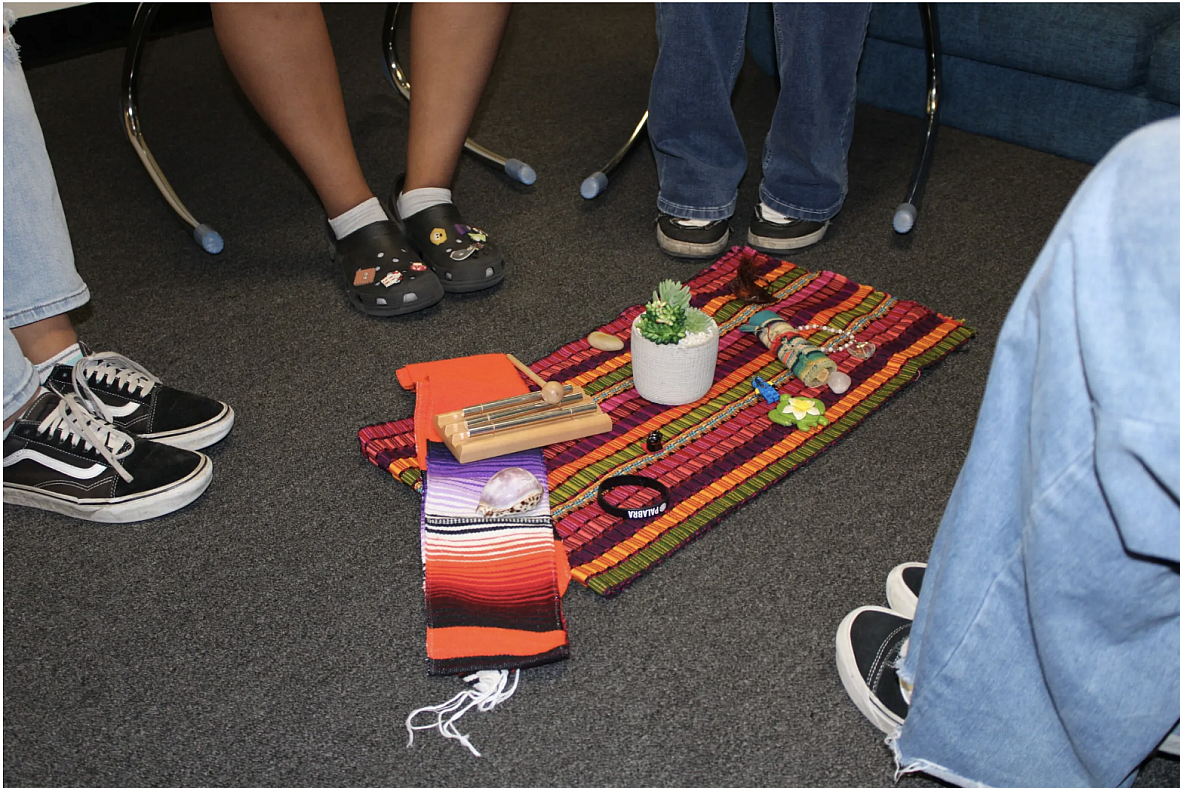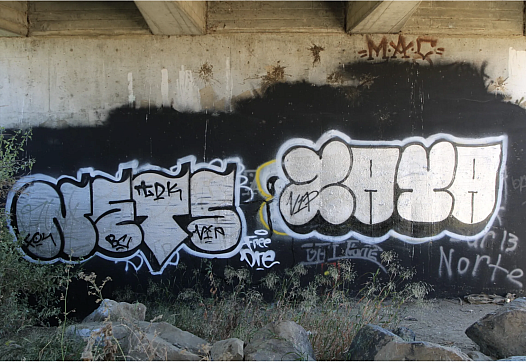BL Special Report: Restorative justice circles help incarcerated and at-risk youth
The story was originally published by BenitoLink with support from our 2024 California Health Equity Fellowship.

Students Participating in a Restorative Justice Circle. For consent purposes only their shoes are displayed.
Photo by Jenna Mayzouni.
When Marisol Palomares sets up a room for a restorative justice circle, she begins by making space for conversation. She moves the tables and arranges the chairs in a circle around the room.
She opens a box and carefully places a blanket, a potted cactus plant, a Lego minifigure, a bracelet, and a few other items of sentimental value to her on the floor in the middle of the circle. Then she lets the students in.
Palomares is a restorative justice specialist at the Youth Alliance, a nonprofit in San Benito and South Santa Clara counties dedicated to providing children and youth equitable opportunities for success through educational programming and community resources.
Once the participants have settled, she begins the circle by reminding them of the guidelines.
- Respect the speaking order.
- Speak from your heart.
- Listen with your heart.
- Speak with respect.
- Listen with respect.
- Remain in the circle.
- Honor confidentiality.
Palomares then guides the students through a community circle, a type of restorative justice exercise meant to help participants build community with their peers, set intentions, address conflict and provide a safe space to discuss what they are going through.
Such circles could be key to providing youth in San Benito County with resources to help them avoid gang recruitment. They could also help former gang members with reentry into society, and help participants avoid reincarceration.
Restorative justice practices have been touted as an alternative to traditional models of criminal justice and law enforcement with a focus on community building and dialogue to prevent repeated arrests and long-term incarceration for youth.
Palomares runs restorative justice circles at four alternative education sites in the county: San Andreas Continuation High School, Santa Ana Opportunity School, Pinnacles Community School, and the county’s Juvenile Hall.
Following the opening of the circle, Palomares takes the students through a mindfulness exercise. She likes to use a chime for this activity. The students are invited to place their hands and feet on the floor and close their eyes while listening to the sound of the chime.
“We want them to focus on the noise so that they can slowly ground themselves and concentrate and feel present during the RJ [restorative justice] circle,” Palomares says.
Palomares facilitates 124 circles a year and serves almost 1,000 students a year. Most of the students participate in a circle monthly or weekly.
In Part 1 of this series, a 17-year-old female who is currently on parole with the county had participated in restorative justice circles through Youth Alliance. She says that they helped her significantly. “A lot of the activities helped me realize my boundaries and personal values,” she says.
Rodrigo “Rigo” Jimenez, associate director of justice and leadership at Youth Alliance, has run the program since 2016 and now works in tandem as the diversion program coordinator at the South County Restorative Justice Youth Diversion Program in Santa Clara County.
He says whenever students or teachers ask him about his job, he answers, “We are here to intentionally build community, if you’re trying to summarize it. The kids start to learn how to regulate themselves, and they start learning to identify their needs.”
Youth Alliance also runs harm reduction circles, focused on helping students and youth take responsibility for their actions and the harm they have caused in the community. It also runs re-entry circles, to help students successfully return to their schools after being incarcerated or released from juvenile hall.
A model that’s proven to work
The restorative justice circles we know today descend from ancient practices that originate with several Indigenous nations in North America and were adapted as an alternative to incarceration beginning in the 1990s.
The counties of Alameda, San Francisco, Los Angeles, and Contra Costa have implemented restorative justice diversion programs as alternative paths to the juvenile penal system. San Benito County does not have a similar program.
Jimenez says he hopes his diversion program in South Santa Clara County encourages the formation of a similar program in San Benito County. “Even if it’s just a pilot program, but to get five or 10 kids and see what it looks like and connect them with resources.”
Youth participants in the Alameda County program were found to be 44% less likely to reoffend compared to their counterparts in the traditional legal system.
The restorative justice model also touts financial benefits. Impact Justice and Community Works estimated in 2015 that it cost Alameda County a $4,500 one-time amount per youth for a restorative community conference, compared to $23,000 per youth each year they are in the traditional juvenile system.
Contra Costa County estimates that in 2019 incarceration in a juvenile facility cost $143,000 per youth each year, whereas sending them to a diversion program cost $10,000.
Palomares, Jimenez, and their colleague Jeanette Neal say they believe in the power of restorative justice, but don’t believe this is an end-all solution to the problem of gangs or juvenile incarceration.
Neal, a parent education coordinator and organizer at Youth Alliance, says: “The cure has to do with the school-to-prison pipeline, poverty and the need for students to finish their education. There’s a lot that goes into that.”
Neal added that restorative justice is a way for its participants to understand there is a community that supports them and wants to understand them in the many ways they feel supported by their gangs.
“They begin to experience true connection with love and encouragement and this causes them to see that they are capable and can have success,” Neal says. “So RJ does not target gang involvement. RJ supports the ability to make better choices and cooperate with a process that supports them.”

The Restorative Justice team at Youth Alliance: Jeanette Neal, Rigo Jimenez, and Marisol Palomares
Credit: Jenna Mayzouni
Through the connections they make with youth during the circles, Palomares and Jimenez have been able to meet their needs by providing resources such as referrals to the county Behavioral Health department, access to food pantries, community hours and volunteer opportunities for students on probation.
Jimenez also hopes that when people give restorative justice a chance, they remember that this work takes time.
“You can’t throw a group of kids in a circle one or two times and expect them to trust you 100 percent,” he says. “It takes a while, and with the way our law enforcement and school systems are built, there can be very little patience with that.”
He says he feels “strongly” that having community-based organizations which support both law enforcement and education is “vital.”
“Giving the community a chance to help heal the community is a beautiful thing. And the community includes our system partners,” he says.
As someone who has witnessed the changes in the individuals he has worked with, Jimenez says he believes in the power of restorative justice.
“To see the impact of an alternative to law enforcement that’s community-driven—what kind of difference can it have on a young person? I promise you, it’s a good one.”

